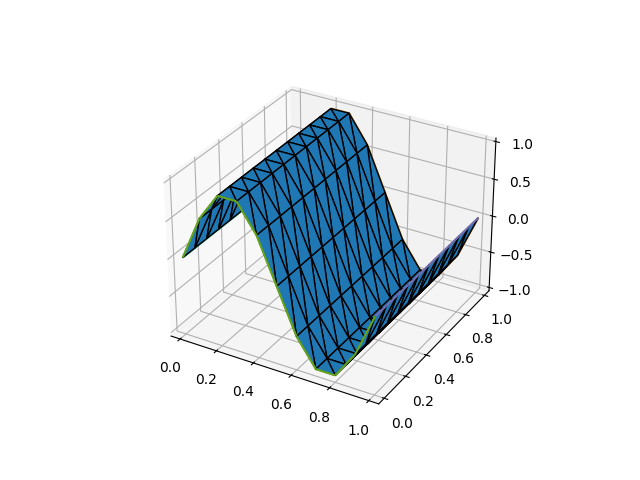Warning
You are reading a version of the website built against the unstable main branch. This content is liable to change without notice and may be inappropriate for your use case.
You can find the documentation for the current stable release here.
Changing mesh coordinates¶
Users may want to change the coordinates of an existing mesh object
for certain reasons. The coordinates can be accessed as a
Function through mesh.coordinates where mesh is
a mesh object. For example,
mesh.coordinates.dat.data[:, 1] *= 2.0
streches the mesh in the y-direction. Another possibility is to use
assign():
Vc = mesh.coordinates.function_space()
x, y = SpatialCoordinate(mesh)
f = Function(Vc).interpolate(as_vector([x, y*2.0]))
mesh.coordinates.assign(f)
This can also be used if f is a solution to a PDE.
Warning
Features which rely on the coordinates field of a mesh’s PETSc DM
(usually a DMPlex) such as VertexOnlyMesh() and
MeshHierarchy() will not work as expected if the
mesh.coordinates field has been modified: at present, the this
does not correspondingly update the coordinates field of the DM.
This will be fixed in a future Firedrake update.
Changing the coordinate function space¶
For more complicated situations, one might wish to replace the mesh
coordinates with a field which lives on a different
FunctionSpace (e.g. higher-order meshes).
Note
Re-assigning the coordinates property of a mesh used to be an
undocumented feature. However, this no longer works:
mesh.coordinates = f # Raises an exception
Instead of re-assigning the coordinates of a mesh, one can create new mesh object from a field f:
new_mesh = Mesh(f)
new_mesh has the same mesh topology as the original mesh, but its
coordinate values and coordinate function space are from f. The
coordinate function space must be a rank-1
FunctionSpace, constructed either with
VectorFunctionSpace(), or by providing a
VectorElement to FunctionSpace(). For
efficiency, the new mesh object shares data with f. That is,
changing the values of f will change the coordinate values of the
mesh, and vice versa. If this behaviour is undesired, one should
explicitly copy:
g = Function(f) # creates a copy of f
new_mesh = Mesh(g)
Or simply:
new_mesh = Mesh(Function(f))
Immersing a mesh in higher dimensional space¶
A useful special case of creating a mesh on modified coordinates is to immerse a lower dimensional mesh in a higher dimension, for example to create a mesh of a two-dimensional manifold immersed in 3D.
This is accomplished by setting the value dimension of the new
VectorFunctionSpace() to that of the space in which it should be
immersed. For example, a mesh of square bent into a sine wave using
linear (flat) elements can be created with:
mesh = UnitSquareMesh(10, 10)
x, y = SpatialCoordinate(mesh)
coord_fs = VectorFunctionSpace(mesh, "CG", 1, dim=3)
new_coord = assemble(interpolate(as_vector([x, y, sin(2*pi*x)]), coord_fs))
new_mesh = Mesh(new_coord)

A sine-wave shaped triangle mesh immersed in three-dimensional space.¶
Replacing the mesh geometry of an existing function¶
Creating a new mesh geometry object, as described above, leaves any
existing Functions untouched – they continue to live
on their original mesh geometries. One may wish to move these
functions over to the new mesh. To move f over to mesh, use:
g = Function(functionspaceimpl.WithGeometry.create(f.function_space(), mesh),
val=f.topological)
This creates a Function g which shares data with f,
but its mesh geometry is mesh.
Warning
The example above uses Firedrake internal APIs, which might change in the future.
